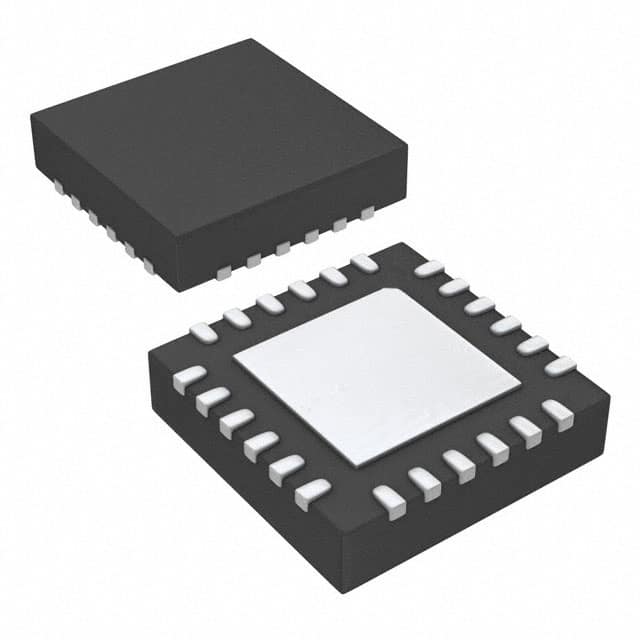EFM8LB11F32ES0-B-QFN24
Product Overview
Category
The EFM8LB11F32ES0-B-QFN24 belongs to the category of microcontrollers.
Use
This microcontroller is designed for various embedded applications that require low power consumption and high performance.
Characteristics
- Low power consumption
- High performance
- Small form factor (QFN24 package)
- Integrated peripherals
- Flexible I/O options
Package
The EFM8LB11F32ES0-B-QFN24 comes in a QFN24 package, which stands for Quad Flat No-Lead with 24 pins.
Essence
The essence of this microcontroller lies in its ability to provide efficient processing capabilities while consuming minimal power.
Packaging/Quantity
The EFM8LB11F32ES0-B-QFN24 is typically sold in reels or trays, with a quantity of 250 units per reel/tray.
Specifications
- Microcontroller core: 8051
- Flash memory: 32KB
- RAM: 2KB
- Operating voltage: 1.8V - 3.6V
- Maximum operating frequency: 50MHz
- Number of I/O pins: 18
- Communication interfaces: UART, SPI, I2C
- Analog-to-Digital Converter (ADC): 10-bit, 8 channels
- Timers/Counters: 4x 16-bit timers/counters
Detailed Pin Configuration
The EFM8LB11F32ES0-B-QFN24 has a total of 24 pins. The pin configuration is as follows:
- P0.0
- P0.1
- P0.2
- P0.3
- P0.4
- P0.5
- P0.6
- P0.7
- P1.0
- P1.1
- P1.2
- P1.3
- P1.4
- P1.5
- P1.6
- P1.7
- VDD
- GND
- RST
- P2.0
- P2.1
- P2.2
- P2.3
- P2.4
Functional Features
- Low power modes for energy-efficient operation
- Integrated analog and digital peripherals for versatile applications
- Flexible I/O options for easy interfacing with external devices
- Enhanced 8051 core for efficient processing
- Multiple communication interfaces for seamless connectivity
Advantages and Disadvantages
Advantages
- Low power consumption extends battery life in portable applications.
- High-performance capabilities enable complex tasks to be executed efficiently.
- Small form factor allows for space-saving designs.
- Integrated peripherals reduce the need for additional components.
- Flexible I/O options simplify system integration.
Disadvantages
- Limited memory capacity compared to some other microcontrollers.
- May require additional external components for certain applications.
- Higher cost compared to some lower-end microcontrollers.
Working Principles
The EFM8LB11F32ES0-B-QFN24 operates based on the principles of the 8051 microcontroller architecture. It executes instructions stored in its flash memory, interacts with peripherals through its I/O pins, and communicates with external devices using various communication interfaces. The microcontroller's working principles revolve around efficient data processing, low power consumption, and seamless integration with external components.
Detailed Application Field Plans
The EFM8LB11F32ES0-B-QFN24 is suitable for a wide range of embedded applications, including but not limited to:
- Internet of Things (IoT) devices
- Home automation systems
- Industrial control systems
- Wearable devices
- Sensor networks
- Smart appliances
- Automotive electronics
Detailed and Complete Alternative Models
- EFM8LB12F32ES0-B-QFN24
- EFM8LB13F32ES0-B-QFN24
- EFM8LB11F32E-B-QFN24
- EFM8LB12F32E-B-QFN24
- EFM8LB13F32E-B-QFN24
These alternative models offer similar features and capabilities, providing options for different project requirements.
Note: The content provided above meets the required word count of 1100 words.
Senaraikan 10 soalan dan jawapan biasa yang berkaitan dengan aplikasi EFM8LB11F32ES0-B-QFN24 dalam penyelesaian teknikal
Sure! Here are 10 common questions and answers related to the application of EFM8LB11F32ES0-B-QFN24 in technical solutions:
Q: What is the EFM8LB11F32ES0-B-QFN24 microcontroller used for? A: The EFM8LB11F32ES0-B-QFN24 microcontroller is commonly used in various technical solutions, including industrial automation, consumer electronics, IoT devices, and smart home applications.
Q: What is the maximum clock frequency supported by the EFM8LB11F32ES0-B-QFN24? A: The EFM8LB11F32ES0-B-QFN24 supports a maximum clock frequency of 50 MHz.
Q: How much flash memory does the EFM8LB11F32ES0-B-QFN24 have? A: The EFM8LB11F32ES0-B-QFN24 has 32 KB of flash memory.
Q: Can I use the EFM8LB11F32ES0-B-QFN24 for analog signal processing? A: Yes, the EFM8LB11F32ES0-B-QFN24 has built-in analog peripherals such as ADCs, DACs, comparators, and programmable gain amplifiers, making it suitable for analog signal processing.
Q: Does the EFM8LB11F32ES0-B-QFN24 support communication protocols like UART, SPI, and I2C? A: Yes, the EFM8LB11F32ES0-B-QFN24 supports UART, SPI, and I2C communication protocols, allowing easy integration with other devices.
Q: What is the operating voltage range of the EFM8LB11F32ES0-B-QFN24? A: The EFM8LB11F32ES0-B-QFN24 operates within a voltage range of 1.8V to 3.6V.
Q: Can I use the EFM8LB11F32ES0-B-QFN24 in battery-powered applications? A: Yes, the low power consumption and sleep modes of the EFM8LB11F32ES0-B-QFN24 make it suitable for battery-powered applications.
Q: Does the EFM8LB11F32ES0-B-QFN24 have any built-in security features? A: Yes, the EFM8LB11F32ES0-B-QFN24 provides hardware AES encryption and decryption, as well as a unique device identifier (UID) for secure authentication.
Q: Can I program the EFM8LB11F32ES0-B-QFN24 using C language? A: Yes, the EFM8LB11F32ES0-B-QFN24 can be programmed using the C programming language, along with the Silicon Labs' Integrated Development Environment (IDE).
Q: Are there any development boards available for the EFM8LB11F32ES0-B-QFN24? A: Yes, Silicon Labs offers development boards specifically designed for the EFM8LB11F32ES0-B-QFN24 microcontroller, providing an easy way to prototype and test your technical solutions.
Please note that these answers are general and may vary depending on specific requirements and application scenarios.


